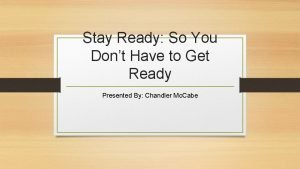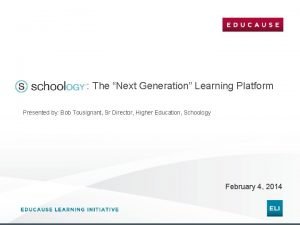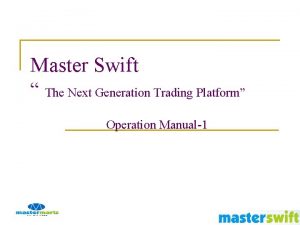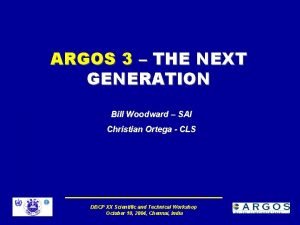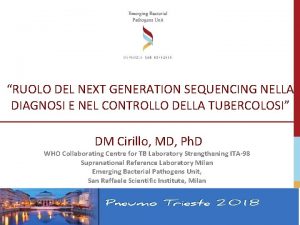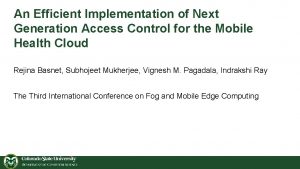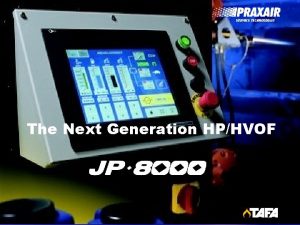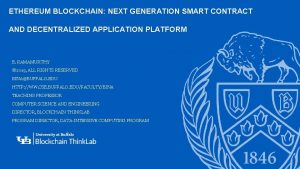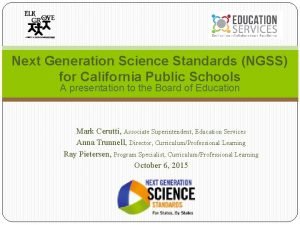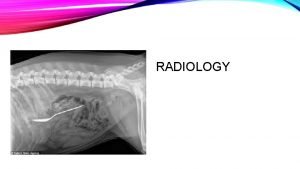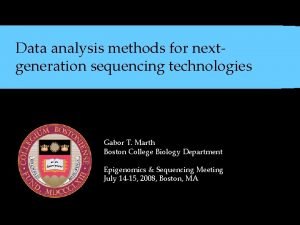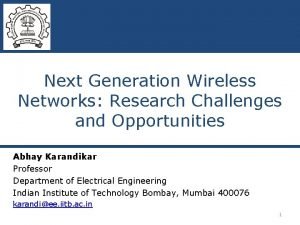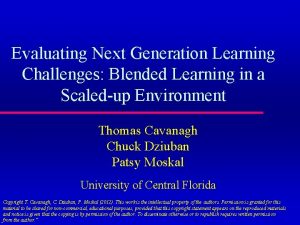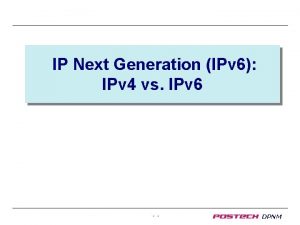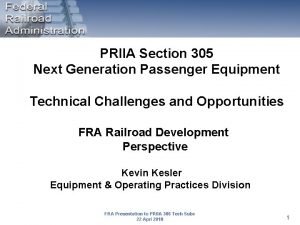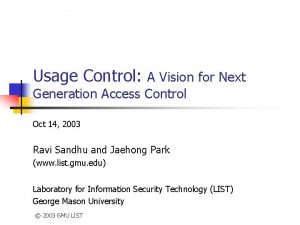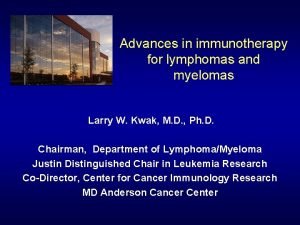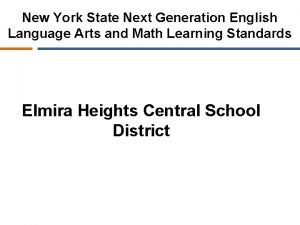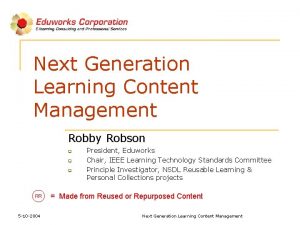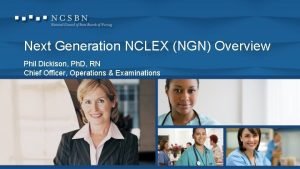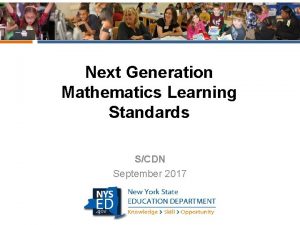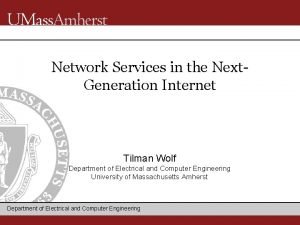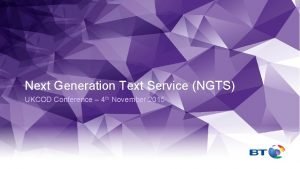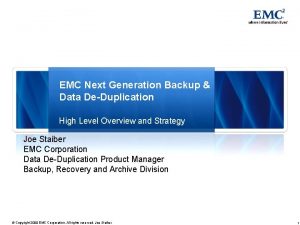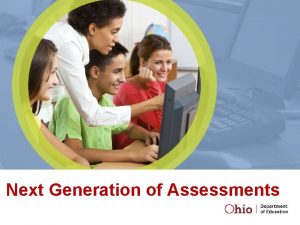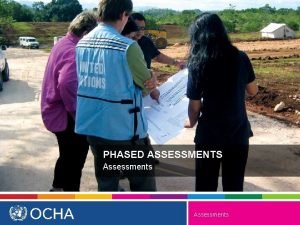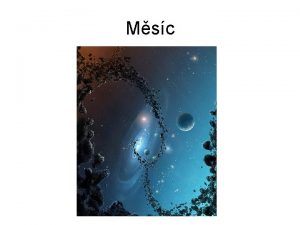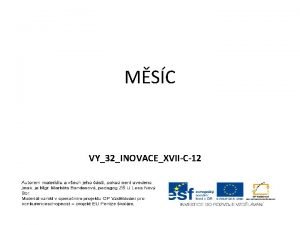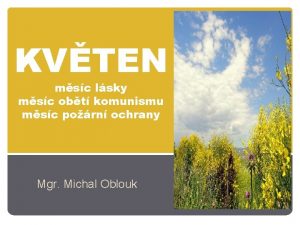MSC 26 Ready or Not Next Generation Assessments








































- Slides: 40

MSC #26 Ready or Not: Next Generation Assessments • Susan Gendron • Senior Fellow • Policy Coordinator, SMARTER • July 2013

Agenda Welcome RR Framework Closing Next Generation of Assessments Assessment: Overview & Information Applications Item Types

Resources

Backward Design “To begin with the end in mind means to start with a clear understanding of your destination. It means you know where you’re going…so the steps you take are always in the right direction. ”

Evidence Based Design

1. Define the domain Common Core Standards Math/ELA 2. Define claims to be made ELA & Math Claims Content Specifications 3. Define assessment targets Knowledge, Skills, & Abilities 4. Define evidence required 5. Develop Task Models 6. Performance Tasks Evidence to be Elicited from Student Methods for Eliciting Evidence

Matrix of Accessibility Features Available to All Available with ISAAP Available with Documentation Embedded English Glossaries Highlighter Mark for Review Masking Writing Tools Zoom Expandable Passages Calculator Digital Notepad Tab-enter Navigation Embedded Math Tools Color Overlays Color Contrast Guided Line Reader Magnification Reverse Contrast Text-to-Speech ASL Audio Captions Braille Translation Option Auditory Calming Non-Embedded Breaks Scratch Paper Color Overlays Abacus Hand-held Calculator Print on Demand Quiet Environment

Figure 1: Conceptual Model of the Smarter Balanced Accessibility and Accommodations Framework • A very small percentage of students participate in alternate assessments aligned to the Common Core State Standards

Three Item Types 1 Evidence-Based Selected Response (EBSR) Selected-response question with a second selected-response question that asks students to show evidence from the text 2 Technology. Enhanced Constructed Response (TECR) Uses technology to capture student comprehension of texts 3 Range of Prose Constructed Responses (PCR) Read and can communicate understanding both in terms of written expression and knowledge of language and conventions Examples include: Multiple-choice +; true-false + drag and drop, cut and paste, shade text, move items to show relationships Examples include: Multipage Essay

Six Item Types 1 2 3 Selected Response Constructed Response Extended Response Students select one response from a provided list Student organizes and uses knowledge and skills to answer a question or complete a task Students prepare a written answer, often a short phrase, a list, or a more substantial composition Examples include: Multiple-choice, truefalse, matching Examples include: short answer, open response, extended response, essay, performance assessment Examples include: Multipage Essay

Six Item Types 4 Performance Task/Assessmen t Activity that requires students to construct a response, create a product or perform a demonstration. Openended-may not have one right answer, rubric used to grade. 5 6 Technology. Enhanced Technology Enabled Items (TEI) are computer -delivered items that include specialized interactions for collecting response data. Allow for non-traditional layout of items that use constructed-response and/or selectedresponses. Examples include: Select a single piece of text and type in a replacement for that text, select options from drop down menu Examples include: sound, computer read aloud, video, interactive widget 11

Claims and Targets Claims Targets • Broad statements of the assessment system’s learning outcomes, each of which requires evidence. • For each Claim, a set of “Assessment Targets” are provided. • Ways in which students may be expected to learn and demonstrate their knowledge • A target represents the prioritized content for summative assessment

Relationship Between Claims and Targets Target 1 Literacy Texts Claim # 1 (LITERACY) Target 2 Target 3 Target 4 -7 Overall Claim (3 -8 or 9 -12) Informational Texts Target 8 Target 9 Claim # 2 (WRITING) Target 10 -14

How do Targets relate to Standards? Target 1 CCSS RL-2 Literacy Texts Claim # 1 (LITERACY) Overall Claim Informational Texts (3 -8 or 9 -12) Claim # 2 (WRITING) Target 2 CCSS L-5 Target 3 CCSS RL-4 Target 4 -7 CCSS RL-5 CCSS L-5 c Target 8 Target 9 Target 10 -14 CCSS L-4

CCSS RL-1 Claim # 1 (LITERACY ) Overall Claim Literacy Texts Target 1 Target 2 CCSS L-5 Target 3 CCSS RL-4 Target 4 -7 CCSS RL-5 CCSS L-5 c Informational Texts (3 -8 or 9 -12) Claim # 2 (WRITING) CCSS RL-2 Target 8 Target 9 CCSS L-4 Target 10 -14 No longer are we looking at standards in isolation. Instead, how do these groups of standards work together to accomplish a task or target?

Rigor/Relevance Framework

Cognitive Rigor and Depth of Knowledge • The level of complexity of the cognitive demand – Level 1/ Quad A: Recall and Reproduction • Requires eliciting information such as a fact, definition, term, or a simple procedure, as well as performing a simple algorithm or applying a formula. – Level 2/ Quad B: Basic Skills and Concepts • Requires the engagement of some mental processing beyond a recall of information. – Level 3/Quad C: Strategic Thinking and Reasoning • Requires reasoning, planning, using evidence, and explanations of thinking. – Level 4: Extended Thinking • Requires complex reasoning, planning, developing, and thinking most likely over an extended period of time.

Defining Relevance

Adding Relevance to Any Lesson Compare Learning to: • Student’s life • Family’s life • Student’s community and • • friends Our world, nation, state World of work World of service World of business and commerce Use the Real World • Moral, ethical, political, • • • cultural points of view and dilemmas Real world materials Internet resources Video and other media Scenarios, real life stories News—periodicals, visual media

Rigor/Relevance Framework

Bloom’s Taxonomy— Technology Version • educationaltechnologyguy. blogspot. com

2 Second Rule The “two-second rule” is used by a driver who wants to maintain a safe following distance at any speed. A driver must count two seconds from when the car in front of him or her passes a fixed point, such as a tree, until the driver passes the same fixed point. Drivers use this rule to determine the minimum distance to follow a car traveling at the same speed. A diagram representing this distance is shown. As the speed of the cars increases, the minimum following distance also increases. Explain how the “two-second rule” leads to a greater minimum following distance as the speed of the cars increases. As part of your explanation, include the minimum following distances, in feet, for cars traveling at 30 miles per hour and 60 miles per hour.








Answer: ¾ of a sandwich is Left for Oscar










 Next generation assessments examples
Next generation assessments examples X.next = x.next.next
X.next = x.next.next Stay ready so you don't have to get ready
Stay ready so you don't have to get ready Stahl
Stahl Lord you are good and your mercy
Lord you are good and your mercy Next generation lms
Next generation lms The next generation
The next generation Palo alto networks next generation security platform
Palo alto networks next generation security platform Next generation trading
Next generation trading Argos next generation
Argos next generation Nextgen electronic medical record
Nextgen electronic medical record Mic next generation sequencing
Mic next generation sequencing Next generation access control
Next generation access control Hp-hvof
Hp-hvof Next-generation smart contracts
Next-generation smart contracts Next generation science standards california
Next generation science standards california Ngn
Ngn Next g network
Next g network Next generation radiology
Next generation radiology Next generation eu immagini
Next generation eu immagini Sinkhole palo alto
Sinkhole palo alto Next generation sequencing methods
Next generation sequencing methods Global next generation wireless communication market
Global next generation wireless communication market Next generation learning challenges
Next generation learning challenges Ip next generation
Ip next generation Priia 305
Priia 305 Next generation access control
Next generation access control Ncdeca.org
Ncdeca.org Vaccine therapy
Vaccine therapy Nys ela standards
Nys ela standards Robson management corporation
Robson management corporation Phil dickison
Phil dickison Nys next generation math standards
Nys next generation math standards Palo alto networks next generation security platform
Palo alto networks next generation security platform Network as a service for next generation internet
Network as a service for next generation internet Next generation text service
Next generation text service The next generation
The next generation Next generation enterprise network
Next generation enterprise network Next generation nclex sample item types
Next generation nclex sample item types Next generation backup
Next generation backup Next generation solution
Next generation solution


